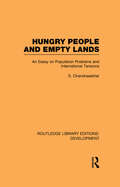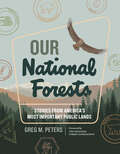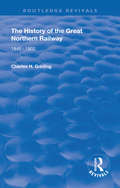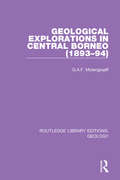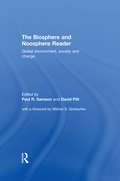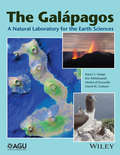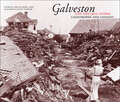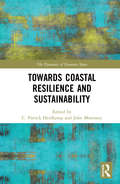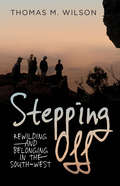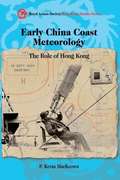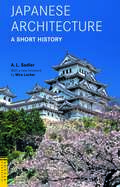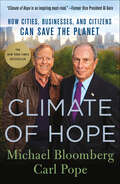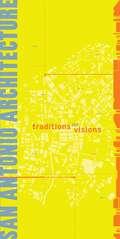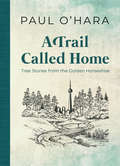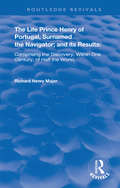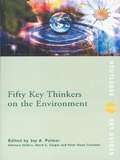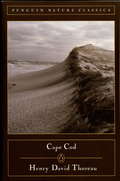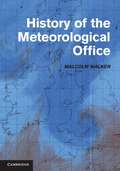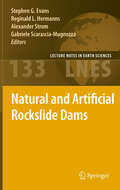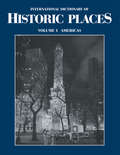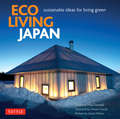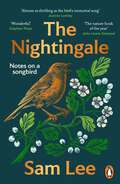- Table View
- List View
Hungry People and Empty Lands: An Essay on Population Problems and International Tensions (Routledge Library Editions: Development)
by S. ChandrasekharFirst published in 1954, this reissue deals with the problem of international tensions arising from demographic and fertility differences, with special reference to such heavily populated Asian countries as China, Japan and India.
Our National Forests: Stories from America's Most Important Public Lands
by Greg M. PetersStories from America&’s Most Important Public Lands Across 193 million acres of forests, mountains, deserts, watersheds, and grasslands, national forests provide a multitude of uses as diverse as America itself. Welcoming 170 million visitors each year to hike, bike, paddle, ski, fish, and hunt, &“the people&’s lands&” offer more than just recreation. Timber is harvested, lost habitats are recovered, and endangered wildlife is protected as part of the Forest Service&’s enduring mission. In Our National Forests, Greg Peters reveals an inside look at America&’s most important public land and the people committed to protecting it and ensuring access for all. From the story of how the Forest Service grows millions of seedlings in the West each year, to their efforts to save the hellbender salamander in Appalachia, the narrative spans the breadth of the country and its diverse ecology. People are at the center of the stories, whether the dedicated folks in the Forest Service, or the everyday citizens who support and tend to the protected lands near their homes. This complete look at America&’s National Forests—their triumphs, challenges, controversies, and vital programs—is a must-read for everyone interested in the history of America's most important public lands.
The History of The Great Northern Railway: 1845 - 1902 (Routledge Revivals)
by Charles H. GrinlingPublished in 1903, this book provides a complete account of the origin and development of the Great Northern Railway Company from its inception to the year 1802, a period of around 60 years.
Geological Explorations in Central Borneo (Routledge Library Editions: Geology #11)
by G.A.F. MolengraaffThis book, first published in 1902, is the product of the detailed geological survey undertaken by the Borneo Expedition of the late nineteenth century. The scientific exploration focused on Central Borneo, especially the sources of the Kapoewas and its tributaries, and its analysis of the geology of the region still today forms the bedrock of research into the area.
The Biosphere and Noosphere Reader: Global Environment, Society and Change
by Paul R. Samson David PittThe Reader is the first comprehensive history of the noosphere and biosphere. Drawing on classical influences, modern parallels, and insights into the future, the Reader traces the emergence of noosphere and biosphere concepts within the concept of environmental change. Reproducing material from seminla works, both past and present, key ideas and writings of prominent thinkers are presented, including Bergson, Vernadsky, Lovelock, Russell, Needham, Huxley, Medawar, Toynbee and Boulding, and extensive introductory pieces bu the editors drawattention to common themes and competing ideas. Focussing on issues of origins, theories, parallels and potential, the discussions place issues in a broad context, compare and contrast central concepts with those of the Gaia hypothesis, sustainability and global change, and examine the potential application of noospheric ideas to current debates about culture, education and technology in such realms as the Internet, space exploration, and the emergence of super-consciousness. Literally the `sphere of mind or intellect', the noosphere is aprt of the `realm of the possible' in human affairs, where there is a conscious effort to tackle global issues The noosphere concept captures a number of key contemporary issues - social evolution, global ecology, Gaia, deep ecology and global environmental change - contributing to ongoing debates concerning the implications of emerging technologies.
The Galapagos: A Natural Laboratory for the Earth Sciences
by Karen S. Harpp Noémi D'Ozouville Eric Mittelstaedt David W. GrahamThe Galápagos Islands are renown for their unique flora and fauna, inspiring Charles Darwin in the elaboration of his theory of evolution. Yet in his Voyage of the Beagle, published in 1839, Darwin also remarked on the fascinating geology and volcanic origin of these enchanted Islands. Since then, the Galápagos continue to provide scientists with inspiration and invaluable information about ocean island formation and evolution, mantle plumes, and the deep Earth.Motivated by an interdisciplinary Chapman Conference held in the Islands, this AGU volume provides cross-disciplinary collection of recent research into the origin and nature of ocean islands, from their deepest roots in Earth's mantle, to volcanism, surface processes, and the interface between geology and biodiversity.Volume highlights include:Case studies in biogeographical, hydrological, and chronological perspectiveUnderstanding the connection between geological processes and biodiversitySynthesis of decades of interdisciplinary research in physical processes from surface to deep interior of the earthIn-depth discussion of the concept of the island acting as a natural laboratory for earth scientistsIntegrated understanding of the Galápagos region from a geological perspectiveCollectively, The Galápagos presents case studies illustrating the Galápagos Archipelago as a dynamic natural laboratory for the earth sciences. This book would be of special interest to a multidisciplinary audience in earth sciences, including petrologists, volcanologists, geochronologists, geochemists, and geobiologists.
Galveston and the 1900 Storm: Catastrophe and Catalyst
by Patricia Bellis Bixel Elizabeth Hayes TurnerThe Galveston storm of 1900 reduced a cosmopolitan and economically vibrant city to a wreckage-strewn wasteland where survivors struggled without shelter, power, potable water, or even the means to summon help. At least 6,000 of the city's 38,000 residents died in the hurricane. Many observers predicted that Galveston would never recover and urged that the island be abandoned. Instead, the citizens of Galveston seized the opportunity, not just to rebuild, but to reinvent the city in a thoughtful, intentional way that reformed its government, gave women a larger role in its public life, and made it less vulnerable to future storms and flooding. This extensively illustrated history tells the full story of the 1900 Storm and its long-term effects. The authors draw on survivors' accounts to vividly recreate the storm and its aftermath. They describe the work of local relief agencies, aided by Clara Barton and the American Red Cross, and show how their short-term efforts grew into lasting reforms. At the same time, the authors reveal that not all Galvestonians benefited from the city's rebirth, as African Americans found themselves increasingly shut out from civic participation by Jim Crow segregation laws. As the centennial of the 1900 Storm prompts remembrance and reassessment, this complete account will be essential and fascinating reading for all who seek to understand Galveston's destruction and rebirth.
Towards Coastal Resilience and Sustainability (The Dynamics of Economic Space)
by C. Patrick Heidkamp John MorrisseyCoastal zones represent a frontline in the battle for sustainability, as coastal communities face unprecedented economic challenges. Coastal ecosystems are subject to overuse, loss of resilience and increased vulnerability. This book aims to interrogate the multi- scalar complexities in creating a more sustainable coastal zone. Sustainability transitions are geographical processes, which happen in situated, particular places. However, much contemporary discussion of transition is either aspatial or based on implicit assumptions about spatial homogeneity. This book addresses these limitations through an examination of socio- technological transitions with an explicitly spatial focus in the context of the coastal zone. The book begins by focusing on theoretical understandings of transition processes specific to the coastal zone and includes detailed empirical case studies. The second half of the book appraises governance initiatives in coastal zones and their efficacy. The authors conclude with an implicit theme of social and environmental justice in coastal sustainability transitions. Research will be of interest to practitioners, academics and decision- makers active in the sphere of coastal sustainability. The multi- disciplinary nature encourages accessibility for individuals working in the fields of Economic Geography, Regional Development, Public Policy and Planning, Environmental Studies, Social Geography and Sociology.
Stepping Off: Rewilding and Belonging in the South-West
by Thomas WilsonStepping Off is a book for locals and travellers alike. It is the story of the south-western corner of Western Australia: an environmental history, a social history, an invitation to reconnect with the land – and in doing so, to reconnect with ourselves.
Early China Coast Meteorology
by P. Kevin MackeownIn this colourful story of the Hong Kong Observatory, P. Kevin MacKeown takes us through the dev
Japanese Architecture: A Short History
by A. L. Sadler Mira LocherA. L. Sadler's invaluable study of Japanese architecture first appeared in 1941. Considered a classic in its field, unequaled in clarity and insight, Japanese Architecture A Short History is a lucid and uncomplicated introduction to this important aspect of Japanese culture. Beginning with the earliest evidences from prehistory and ending with the Edo period, when Japan attained stature as a modern state, Japanese Architecture is as relevant today as it was in 1941.
Climate of Hope: How Cities, Businesses, and Citizens Can Save the Planet
by Michael Bloomberg Carl PopeNEW YORK TIMES BESTSELLERFrom Mayor Michael Bloomberg and former head of the Sierra Club Carl Pope comes a manifesto on how the benefits of taking action on climate change are concrete, immediate, and immense. They explore climate change solutions that will make the world healthier and more prosperous, aiming to begin a new type of conversation on the issue that will spur bolder action by cities, businesses, and citizens—and even, someday, by Washington."Climate of Hope is an inspiring must read." —Former Vice President Al Gore, Chairman of The Climate Reality Project“Climate change threatens to reshape the future of our world's population centers. Bloomberg and Pope have been leaders on fortifying our cities against this threat, and their book proves that victory is possible—and imperative.” —Leonardo DiCaprio"If Trump is looking for a blueprint, he could not do better than to read a smart new book, Climate of Hope." —Thomas Friedman in The New York Times~The 2016 election left many people who are concerned about the environment fearful that progress on climate change would come screeching to a halt. But not Michael Bloomberg and Carl Pope. Bloomberg, an entrepreneur and former mayor of New York City, and Pope, a lifelong environmental leader, approach climate change from different perspectives, yet they arrive at similar conclusions. Without agreeing on every point, they share a belief that cities, businesses, and citizens can lead—and win—the battle against climate change, no matter which way the political winds in Washington may shift. In Climate of Hope, Bloomberg and Pope offer an optimistic look at the challenge of climate change, the solutions they believe hold the greatest promise, and the practical steps that are necessary to achieve them. Writing from their own experiences, and sharing their own stories from government, business, and advocacy, Bloomberg and Pope provide a road map for tackling the most complicated challenge the world has ever faced. Along the way, they turn the usual way of thinking about climate change on its head: from top down to bottom up, from partisan to pragmatic, from costs to benefits, from tomorrow to today, and from fear to hope.
San Antonio Architecture
by Boone Powell San AntonioWith a history more than 290 years old, San Antonio boasts a diverse, eclectic, and important architectural inventory. From the Spanish Missions of the 17th century to invigorating adaptation and restoration of historic buildings alongside landmark new construction, there is a wide array of culturally significant assets reflecting Anglo and Hispanic traditions, alongside regional variations of southern and southwestern American styles.San Antonio Architecture is the comprehensive catalog of the architecture inventory of the city. Complete with color illustrations, keyed maps, and informative essays, it is a must-have book for every armchair and on foot architectural, art, and community historian.
San Antonio Architecture
by San Antonio Boone PowellWith a history more than 290 years old, San Antonio boasts a diverse, eclectic, and important architectural inventory. From the Spanish Missions of the 17th century to invigorating adaptation and restoration of historic buildings alongside landmark new construction, there is a wide array of culturally significant assets reflecting Anglo and Hispanic traditions, alongside regional variations of southern and southwestern American styles.San Antonio Architecture is the comprehensive catalog of the architecture inventory of the city. Complete with color illustrations, keyed maps, and informative essays, it is a must-have book for every armchair and on foot architectural, art, and community historian.
San Antonio Architecture
by San Antonio Boone PowellWith a history more than 290 years old, San Antonio boasts a diverse, eclectic, and important architectural inventory. From the Spanish Missions of the 17th century to invigorating adaptation and restoration of historic buildings alongside landmark new construction, there is a wide array of culturally significant assets reflecting Anglo and Hispanic traditions, alongside regional variations of southern and southwestern American styles.San Antonio Architecture is the comprehensive catalog of the architecture inventory of the city. Complete with color illustrations, keyed maps, and informative essays, it is a must-have book for every armchair and on foot architectural, art, and community historian.
A Trail Called Home: Tree Stories from the Golden Horseshoe
by Paul O'HaraAn exploration of trees in the Golden Horseshoe and the stories they tell. Trees define so much of Canadian life, but many people, particularly in the Golden Horseshoe area of Ontario, don’t know that much about them. Granted, it is harder here: there are more trees that are native to this area than anywhere else in Canada. The great storytellers of the landscape, trees are looking glasses into the past. They speak of biology, ecology, and geology, as well as natural and human history. Through a greater understanding of trees, we can become more rooted to the land beneath our feet, and our place in it.
The Life of Prince Henry of Portugal: Surnamed the Nabigator and its Results (Routledge Revivals)
by Richard Henry MajorOriginally published in 1868, this book follows the life of Prince Henry, including chapters on the Siege of Tangier, the capture of Ceuta and the death of Prince Henry.
Fifty Key Thinkers on the Environment (Routledge Key Guides)
by Joy A. PalmerFifty Key Thinkers on the Environment is a unique guide to environmental thinking through the ages. Joy A. Palmer, herself an important and prolific author on environmental matters, has assembled a team of thirty-five expert contributors to summarize and analyse the thinking of fifty diverse and stimulating figures – from all over the world and from ancient times to the present day. Among those included are: Philosophers such as Rousseau, Spinoza and Heidegger Activists such as Chico Mendes Literary giants such as Virgil, Goethe and Wordsworth Major religious and spiritual figures such as the Buddha and St Francis of Assisi. Lucid, scholarly and informative, these fifty essays offer a fascinating overview of mankind’s view and understanding of the physical world.
Cape Cod
by Henry David Thoreau Paul TherouxThoreau's classic account of his meditative, beach-combing walking trips to Cape Cod in the early 1850s, reflecting on the elemental forces of the sea Cape Cod chronicles Henry David Thoreau's journey of discovery along this evocative stretch of Massachusetts coastline, during which time he came to understand the complex relationship between the sea and the shore. He spent his nights in lighthouses, in fishing huts, and on isolated farms. He passed his days wandering the beaches, where he observed the wide variety of life and death offered up by the ocean. Through these observations, Thoreau discovered that the only way to truly know the sea--its depth, its wildness, and the natural life it contained--was to study it from the shore. Like his most famous work, Walden, Cape Cod is full of Thoreau's unique perceptions and precise descriptions. But it is also full of his own joy and wonder at having stumbled across a new frontier so close to home, where a man may stand and "put all America behind him." Part of the Penguin Nature Library Series Editor: Edward Hoagland With an Introduction by Paul Theroux
History of the Meteorological Office
by Malcolm WalkerMalcolm Walker tells the story of the UK's national meteorological service from its formation in 1854 with a staff of four to its present position as a scientific and technological institution of national and international importance with a staff of nearly two thousand. The Met Office has long been at the forefront of research into atmospheric science and technology and is second to none in providing weather services to the general public and a wide range of customers around the world. The history of the Met Office is therefore largely a history of the development of international weather prediction research in general. In the modern era it is also at the forefront of the modelling of climate change. This volume will be of great interest to meteorologists, atmospheric scientists and historians of science, as well as amateur meteorologists and anyone interested generally in weather prediction.
History of the Meteorological Office
by J. M. WalkerMalcolm Walker tells the story of the UK's national meteorological service from its formation in 1854 with a staff of four to its present position as a scientific and technological institution of national and international importance with a staff of nearly two thousand. The Met Office has long been at the forefront of research into atmospheric science and technology and is second to none in providing weather services to the general public and a wide range of customers around the world. The history of the Met Office is therefore largely a history of the development of international weather prediction research in general. In the modern era it is also at the forefront of the modelling of climate change. This volume will be of great interest to meteorologists, atmospheric scientists and historians of science, as well as amateur meteorologists and anyone interested generally in weather prediction.
Natural and Artificial Rockslide Dams
by Reginald L. Hermanns Alexander Strom Stephen G. Evans Gabriele Scarascia-MugnozzaIn the last one hundred years, a number of catastrophic events associated with rockslide dam formation and failure have occurred in the mountain regions of the world. This book presents a global view of the formation, characteristics and behaviour of natural and artificial rockslide dams. Chapters include a comprehensive state-of-the-art review of our global understanding natural and artificial rockslide dams, overviews of approaches to rockslide dam risk mitigation, regional studies of rockslide dams in India, Nepal, China, Pakistan, New Zealand, and Argentina. Rockslide dams associated with large-scale instability of volcanoes are also examined. Detailed case histories of well-known historic and prehistoric rockslide dams provide examples of investigations of rockslide dam behaviour, stability, and characteristics. The formation and behaviour of rockslide-dammed lakes ("Quake Lakes") formed during the 2008 Wenchuan Earthquake, China are also comprehensively summarised. The formation, sedimentology and stability of rockslide dams is examined in several analytical papers. An analysis of break-out floods from volcanogenic lakes and hydrological methods of estimating break-out flood magnitude and behavior are reviewed. The use of remote sensing data in rockslide-dammed lake characterisation is explored and a new approach to the classification of rockslide dams is introduced. Finally, a unique section of the book summarises Russian and Kyrgyz experience with blast-fill dam construction in two papers by leading authorities on the technology. The volume contains 24 papers by 50 authors from 16 countries including most of the recognised world authorities on the subject.
The Americas: International Dictionary of Historic Places
by Trudy Ring Robert M. Slakin Sharon La BodaFirst Published in 1996. Routledge is an imprint of Taylor & Francis, an informa company.
Eco Living Japan: Sustainable Ideas for Living Green
by Deanna MacdonaldJapan is equally as well known for its ecologically-sensitive traditional homes as it is for cutting-edge, green technology.Eco Living Japan presents 19 contemporary Japanese houses which exemplify the most recent trends in sustainable design in Japan. This is wabi-sabi for the 21st century! With over 250 photos, drawings, plans and lively, informative text, this sustainable architecture book offers a picture of green living in contemporary Japan and provides inspiration and practical ideas for those creating homes in North America and other 4 season climates. Each project presents different aspects of Japan's current movement toward a more sustainable living environment as well as its focus on fine craftsmanship and cutting-edge technology.The book's content is informative and enjoyable for both professional architects and forward-thinking homeowners. Anyone with an interest in Japanese design and trends in sustainable living will find fresh ideas for their own home projects. These homes work in harmony with their environments and with the people who inhabit them- "green design" at its best!
The Nightingale: ‘The nature book of the year’
by Sam Lee'Wondering and wonderful. The nature book of the year.' JOHN LEWIS-STEMPEL'This lovely book is almost as thrilling as the bird's immortal song - balm for a troubled soul and a glimpse of paradise.' JOANNA LUMLEY______________________________Come to the forest, sit by the fireside and listen to intoxicating song, as Sam Lee tells the story of the nightingale.Every year, as darkness falls upon woodlands, the nightingale heralds the arrival of Spring. Throughout history, its sweet song has inspired musicians, writers and artists around the world, from Germany, France and Italy to Greece, Ukraine and Korea. Here, passionate conservationist, renowned musician and folk expert Sam Lee tells the story of the nightingale. This book reveals in beautiful detail the bird's song, habitat, characteristics and migration patterns, as well as the environmental issues that threaten its livelihood.From Greek mythology to John Keats, to Persian poetry and 'A Nightingale Sang in Berkeley Square', Lee delves into the various ways we have celebrated the nightingale through traditions, folklore, music, literature, from ancient history to the present day. The Nightingale is a unique and lyrical portrait of a famed yet elusive songbird.______________________________'Sam Lee has brought the poetic magic that has long enchanted so many of his musical fans into the written word. Allow yourself to glimpse the world Sam sees, to be part of his love affair with the nightingale, and you will no doubt be delighted.' LILY COLE'A wonderful book.' STEPHEN MOSS'A magical marriage of the lyrical and practical: a book that makes us want to seek out the nightingale and then reveals how we can.' TRISTAN GOOLEY
